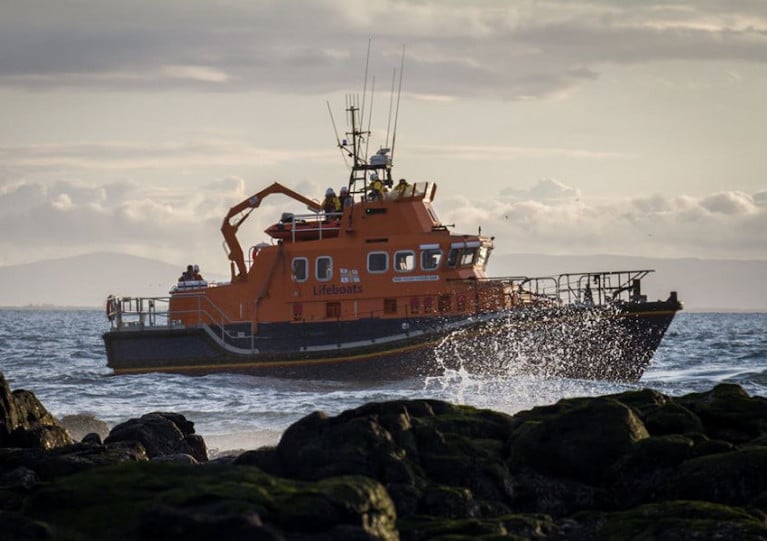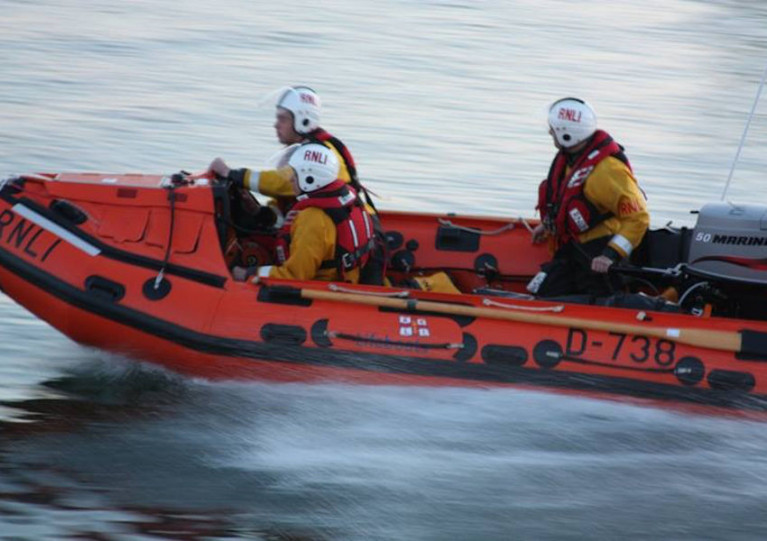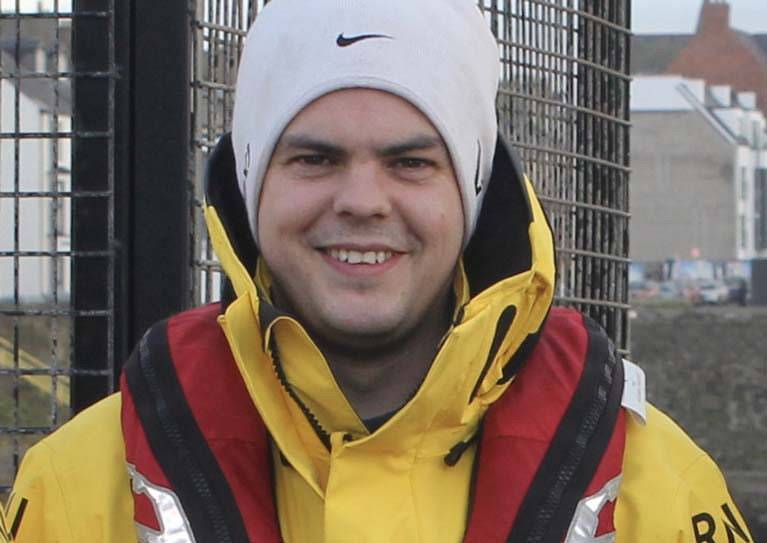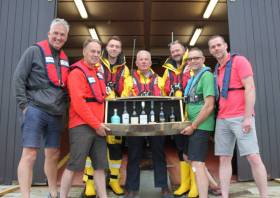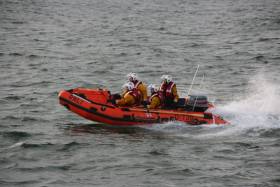Displaying items by tag: Portrush
Portrush RNLI’s all-weather lifeboat ran aground temporarily as it assisted an angling boat in difficulty in the Foyle Estuary yesterday afternoon (Sunday 28 June).
The volunteer crew had launched at 3.40pm to reports of a 24ft angling boat in difficulty at the entrance to the Foyle Estuary.
Weather conditions at the time were near gale-force with winds gusting from the west, which made the rescue challenging.
On arriving at the scene, the lifeboat crew established a tow line with the fishing vessel at around 4.27pm and proceeded at a slow speed back to Portrush Harbour in Co Antrim where it arrived about an hour later.
In the extreme weather conditions, the lifeboat temporarily went aground while assisting the casualty vessel to reach the pontoon.
As a safety precaution, the all-weather lifeboat was taken off service to allow a full inspection take place today. Portrush RNLI’s inshore lifeboat remains on service.
The volunteer lifeboat crew acknowledged the help given by local fisherman Richard Connor and the local coastguard team in assisting the lifeboat to get onto the pontoon.
Both the lifeboat crew and the crew of the angling boat were unharmed.
However, it’s understood that a member of the coastguard sustained a hand injury in helping at the scene. Portrush RNLI sends him their best wishes for a full recovery.
Both Portrush RNLI lifeboats were requested to launch by HM Coastguard yesterday afternoon (Saturday 20 June) to reports of person on an inflatable paddleboard in difficulty in the sea just off Portstewart on Northern Ireland’s North Coast.
The inshore lifeboat was launched at 1.23pm initially into a slight sea swell with an offshore wind and made their way to Portstewart, followed by the all-weather lifeboat 10 minutes later.
The inshore crew arrived on scene at 1.35pm and successfully recovered the casualty who was 200 metres from shore. The crew found that the casualty had been blown out to sea, had fallen off their board and been unable to get back on.
Both casualty and their board were swiftly returned to shore where they were handed over to the care of the coastguard and NI Ambulance Service who had been called as a precaution. The all-weather lifeboat was stood down.
Ivor Paul, deputy launching authority at Portrush RNLI, said: “We would urge people not to bring inflatables to the coast as it is so easy to get caught by the wind and within seconds you can suddenly be in danger. If in doubt talk, to the lifeguards and check out the RNLI and coastguard websites for guidance and advice.”
Portrush RNLI’s lifeboats aided in the rescue of a young man who fell 30 feet onto rocks on the north coast last night (Wednesday 10 June).
Both the inshore and all-weather lifeboats were launched as a precaution due to the nature of the incident, after reports that the man had fallen at Port-Na-Happle just off the Convent Walk, a popular scenic coastal path in Portstewart.
Volunteer lifeboat crew member Dr Colm Watters, who is a consultant at Causeway Hospital’s emergency department, was transferred ashore to assist the local coastguard with the treatment of the casualty before he was passed into the care of the NI Ambulance Service.
Lifeboat operations manager Keith Gilmore said later: “We had the opportunity to do some training with our coastguard colleagues last year and this has paid off in terms of our joint working procedures.
“We are fortunate to have a volunteer with Colm’s expertise on crew and this was invaluable in this incident. We wish the casualty well and hope he has a speedy recovery.”
Earlier in the day, Wicklow RNLI brought three fishermen to safety at lunchtime after their 12-metre vessel got into difficulties off the Wicklow coast.
The alarm was raised earlier in the morning after the fishing boat’s propeller got fouled in ropes near the Codling Buoy.
Crew of the all-weather lifeboat Jock & Annie Slater located the drifting fishing vessel 14 miles east of Wicklow Harbour and quickly established a tow. The boat was safely tied alongside the South Quay at 12:30pm.
Portrush RNLI Appoints a New Coxswain Mechanic
Portrush RNLI has appointed a new Coxswain/Mechanic to replace the recently retired Anthony Chambers. Dave Robinson has been a popular volunteer crew member at the station for seven years and was successful at interview in February 2020.
Dave (aged 27) was recently employed with the Merchant Navy in the North Sea and is delighted to have a job with the RNLI which combines his love of the Lifeboat and being based permanently at home. His fiancée, Livvy is also delighted as the pair are getting married in May this year and have recently bought a house in Portrush.
Dave’s responsibilities will include looking after and maintaining the two Lifeboats at Portrush- The Severn and the D class, as well as making sure all PPE is in order and ensuring all equipment is fit for purpose. He will be a key member of the Operations Team, working closely with the Lifeboat Operations Manager, Deputy Launching Authorities and the other volunteer coxswains on station.
Dave said:- This is a dream come true for me as I have enjoyed working as a volunteer for so many years and learning from the best. Portrush Lifeboat Station is a wonderful station to be associated with and am looking forward to getting started’
Keith Gilmore, Lifeboat Operations Manager said:- I am very pleased with the appointment of David Robinson as Coxswain/Mechanic of Portrush Lifeboat. David has been a dedicated and effective volunteer crewmember for seven years. The experience that he has gained during that time, both on the lifeboat, and in the challenging conditions of the North Sea in the Merchant Navy, ensure that he has the total confidence of the crew in his suitability to take on this new role. Well done David!
Portrush Lifeboat Teams Bid Farewell To ‘True Legend’ As Coxswain Anthony Chambers Retires
Lifeboat teams from Portrush and farther afield gathered in the North Coast town on Friday (28 February) to bid farewell to one of their own, as mechanic/coxswain and crew member Anthony Chambers retires after more than 40 years.
The Chambers family have been linked to Portrush RNLI in Northern Ireland for generations. Anthony’s father Gilbert and brother Derek were both mechanics on the lifeboat before him, and Anthony’s two nephews, Jason and Karl, are following the family tradition of being volunteer crew and an integral part of the station.
But Friday night was all about Anthony — celebrating his career, his retirement, remembering great rescues and the difference he has made to so many people.
Anthony’s most memorable and heroic ‘shout’ was the rescue of two young boys from a cave in August 2009 against a rising tide.
Part of the account of the rescue said: “Anthony fought against the elements in almost total darkness, being smashed against the cave wall … rescuing the boys one by one. It took him 30 minutes to complete the difficult and treacherous return swim twice with the rising tide against him.”
As a result, Anthony was presented with a bronze medal for gallantry in May 2010 by HRH Prince Michael of Kent at the Barbican in London, and fellow crew members with him on that night were presented with a letter of thanks from the RNLI.
This was only one example of Anthony’s bravery and on Friday night, the lifeboat crew, fundraising team and friends gathered in Portrush Yacht Club to celebrate, present gifts and reminisce of rescues gone by.
 Portrush lifeboat crew with Anthony Chambers | Photo: RNLI/Judy Nelson
Portrush lifeboat crew with Anthony Chambers | Photo: RNLI/Judy Nelson
It was a testament to Anthony’s popularity that Portrush Yacht Club was packed to capacity with ex-crew members and representatives from Lough Swilly, Red Bay, Larne, Ballyglass, Portpatrick and Donaghadee lifeboat stations.
It was an opportunity for Anthony’s family, his wife Maryna, son Alistair and stepdaughter Louise, to meet so many of his colleagues in the RNLI and hear of his many exploits.
The formal part of the evening was introduced by MC and fellow lifeboat crew member Tim Nelson. Volunteer coxswain Des Austin presented gifts on behalf of the crew and Keith Gilmore, lifeboat operations manager, presented a vellum and letter of thanks from Mark Dowie, chief executive of the RNLI.
John Martin from the fundraising team also presented gifts on behalf of the team. Shirley Austin, Des’s wife, presented Anthony’s wife Maryna with flowers on behalf of the crew.
Beni McAllister, honorary secretary of Portrush Yacht Club, presented Anthony with a life membership of the club in recognition of its close links with the lifeboat station.
Anthony took to the floor to thank everyone for the gifts and good wishes. He went on to wish the current crew well and also the new coxswain/mechanic Dave Robinson, who takes over the helm.
Sailors Do A ‘Whiskey Run’ For Portrush & Islay Lifeboats
A group of seven men from the North Coast hatched a novel way to carry out some fundraising for the Portrush and Islay RNLI volunteer lifeboat crews recently.
As a group of keen sailors and avid supporters of the RNLI and the Scottish islands, they wanted to marry the two passions together and have some fun along the way.
The team decided to row to Islay to recreate a journey made over the generations using only manpower to raise money for the lifeboats.
The team was fortunate to be able to borrow ‘Home to Portrush’, the famous local boat that had crossed the Atlantic in record time in February 2018. Their challenge was to visit all the coastal distilleries on Islay and collect some whiskey from each one.
Ashley Moore, one of the crew, said: “We left from Ballintoy at 3am in idyllic conditions in order to reach Port Ellen and not be swept around the headland as the tide turned.
“Thankfully we made it in nine-and-a-half hours and over the next three days went on to visit Laphroaig, Lagavulin, Ardbeg, Coal Ila, Bunnahabhain, Bowmore and Bruichladdich, collecting whisky bottles along the way.
“We were blown away by the warmth of the welcome across Islay and the distilleries — we were given many offers of food and accommodation and each distillery presented us with a bottle of whisky and a stave from one of their barrels to allow us to create the Islay Sea Collection.”
On returning home, team member and local architect Graeme Montgomery set out to design and create a unique cask to display the bottles of whisky, with the source of each stave marked.
‘This is a really exciting and novel way to raise funds for the two stations’
Bids are now being accepted until Sunday 17 November at just-whisky.co.uk for this ‘one of a kind’ whisky collection — and sponsors, including Coleraine software company Spatialest, have already pledged £2,000.
To register to bid you will have to pay £5 but this will be donated to RNLI. During registration, under box number 2 will see a box asking you to leave a message — in this box you must type in RNLI BID to ensure that the £5 registration fee comes to Portrush and Islay RNLI.
Portrush lifeboat operations manager Keith Gilmore said: “This is a really exciting and novel way to raise funds for the two stations. We often have to work with Islay, and this is a great way to work with one of our neighbours and local supporters to raise funds for the RNLI.”
Ashley Moore added: “This was a really fun way to see the Scottish islands in a different way while helping to raise funds to support the work of the RNLI – and to enjoy some exceptional whisky!
“As sea lovers each one of our team never takes for granted the exceptional and brave work of the lifeboat crews and we are so grateful to know they are there whenever needed.”
Portrush RNLI’s volunteer crew launched yesterday evening (Monday 22 July) to reports of a jetskier in difficulty at Benone Beach around 8.17pm.
The crew, who had just finished an exercise and had been stood down, launched the all-weather lifeboat in record time after the HM Coastguard request.
It was reported that three persons had already entered the water to assist the jetskier but had to return to shore to receive medical attention from the coastguard.
The lifeboat crew reached the jetskier at 8.35pm in smooth seas but with a strong offshore breeze which had hindered the three people attempting to assist.
After the jetski was secured alongside the lifeboat, the crew took the casualty on board, where he assessed and deemed to be medically fit.
It was then decided that the jetskier and his craft should be taken back to the beach, using the all-weather lifeboat’s smaller Y boat, to the waiting coastguard.
Des Austin, coxswain of Portrush RNLI, said after the callout: “The jetskier had no wetsuit on and even in a balmy summer evening the water is still very cold, so it was important that we reached him as soon as we could.
“There was also a strong off shore wind which made it difficult for the other swimmers to assist, so the members of the public did exacty the right thing by calling for help.
“It’s also key for us to make sure that the jetski is recovered also as it could pose a hazard if not taken out of commission.”
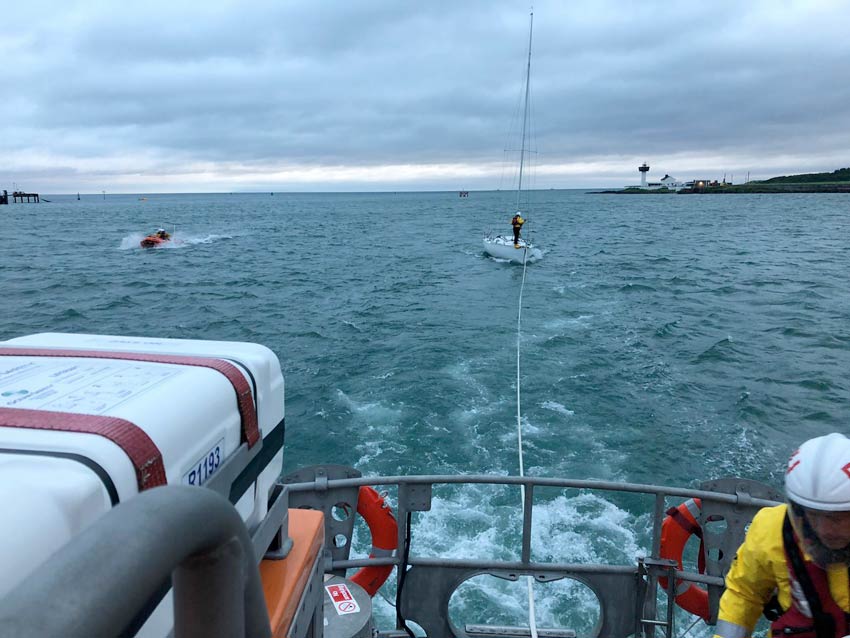 Larne RNLI tows the 37ft yacht back to East Antrim Boat Club | Photo: RNLI/Samantha Agnew
Larne RNLI tows the 37ft yacht back to East Antrim Boat Club | Photo: RNLI/Samantha Agnew
Much earlier in the day, Larne RNLI volunteers’ pagers sounded at 5am after reports that a 37ft yacht had broken its moorings at East Antrim Boat Club and run aground in Larne Lough, causing a potential hazard to the shipping lanes.
Both lifeboats were launched 10 minutes later in moderate seas on an overcast morning, and once on scene it was decided to place a crew member from the inshore lifeboat on the casualty vessel to secure a tow line.
Once brought into deeper water and assessed as being safe and undamaged, the yacht was then towed by the larger all-weather lifeboat to a spare mooring back at East Antrim Boat Club.
“It was an early start for our volunteers this morning and we had a good turnout of crew for the callout.” said Larne’s lifeboat operations manager Allan Dorman.
“This scenario is something that we practice during training and I was glad to see that everyone worked together for a successful outcome.”
Portrush RNLI’s volunteer crew were requested to launch at 6.03pm last night (Tuesday 25 June) to reports of two swimmers in difficulty in the vicinity of Dunluce Castle.
Belfast Coastguard’s initial request to launch was based on reports of a man in the water who was unable to get back to shore.
The inshore lifeboat (ILB) crew who were already at the station to undergo assessments launched immediately, and arrived on scene at 6.15pm to discover that there were actually two people in the water.
The second person had entered the water to try to rescue the first swimmer, but was unable to get him back to shore because of the strong tidal stream.
However, the second person was able to keep the first above water until the volunteer crew arrived.
The ILB crew got the two casualties into the lifeboat and transported them back to Portballintrae, where the Northern Ireland Ambulance Service was waiting along with the Air Ambulance NLI. RNLI lifeguards were also in attendance, along with the coastguard.
Keith Gilmore, lifeboat operations manager at Portrush, said: “The swimmer was very lucky that there was someone on scene to assist while the inshore lifeboat launched and arrived on scene.”
He added: “This is the classic scenario that we train for each week, and the crew are very skilled and highly trained for this type of rescue. We would like to wish the two casualties a speedy recovery.”
The condition of the two casualties is unknown at this time.
Portrush RNLI’s volunteer crew were requested to launch at 4.32pm on Father’s Day (Sunday 16 June) to reports of a broken-down RIB with six people on board, some three nautical miles north-east of Inishowen.
The lifeboat crew arrived on scene at 4.55pm and established a tow line to the 10m RIB. The boat was then brought back to Portrush Harbour where the coastguard were also in attendance to assist.
Speaking following the callout, lifeboat operations manager Keith Gilmore said: “This was a classic tow rescue which the crew train for on a regular basis. Conditions were very favourable which made it easier to recover the vessel and establish the tow.
“We also had two of our new crew members on the all-weather lifeboat today so this was a good opportunity for them to put their training into practice under the supervision of our more experienced crew.
“The all-weather lifeboat and the volunteer crew arrived back in Portrush at 6.10pm just in time for Father’s Day evening dinner.”
#RNLI - Portrush RNLI’s all-weather lifeboat was launched last night (Thursday 2 August) to assist with the recovery of a man who had fallen from Elephant Rock into the sea at Ballintoy.
The volunteer crew launched the lifeboat at 6.45pm and arrived on scene at Ballintoy, some 17 miles east of Portrush, accompanied by the Northern Ireland Air Ambulance, NI Ambulance Service and HM Coastguard. The Rescue 199 coastguard helicopter from Prestwick was also tasked.
The casualty was quickly located and the small inflatable Y boat was deployed from the all-weather lifeboat to the outcrop in order to assess his injuries.
The Y boat crew transferred the casualty onto a basket stretcher to prepare for evacuation back to the harbour, where he was transferred to the air ambulance and taken to hospital in Belfast.
Speaking following the callout, Portrush RNLI lifeboat operations manager Keith Gilmore said: “This was a classic operation for our volunteer lifeboat crew and something they train for on a regular basis.
“The crew work closely with the ambulance service, the helicopter pilots and the coastguard regularly to make sure we are ready for this sort of situation. It takes skill and patience to execute this type of manoeuvre but something they do with skill and expertise.
“We would like to wish the casualty a speedy recovery.”


























